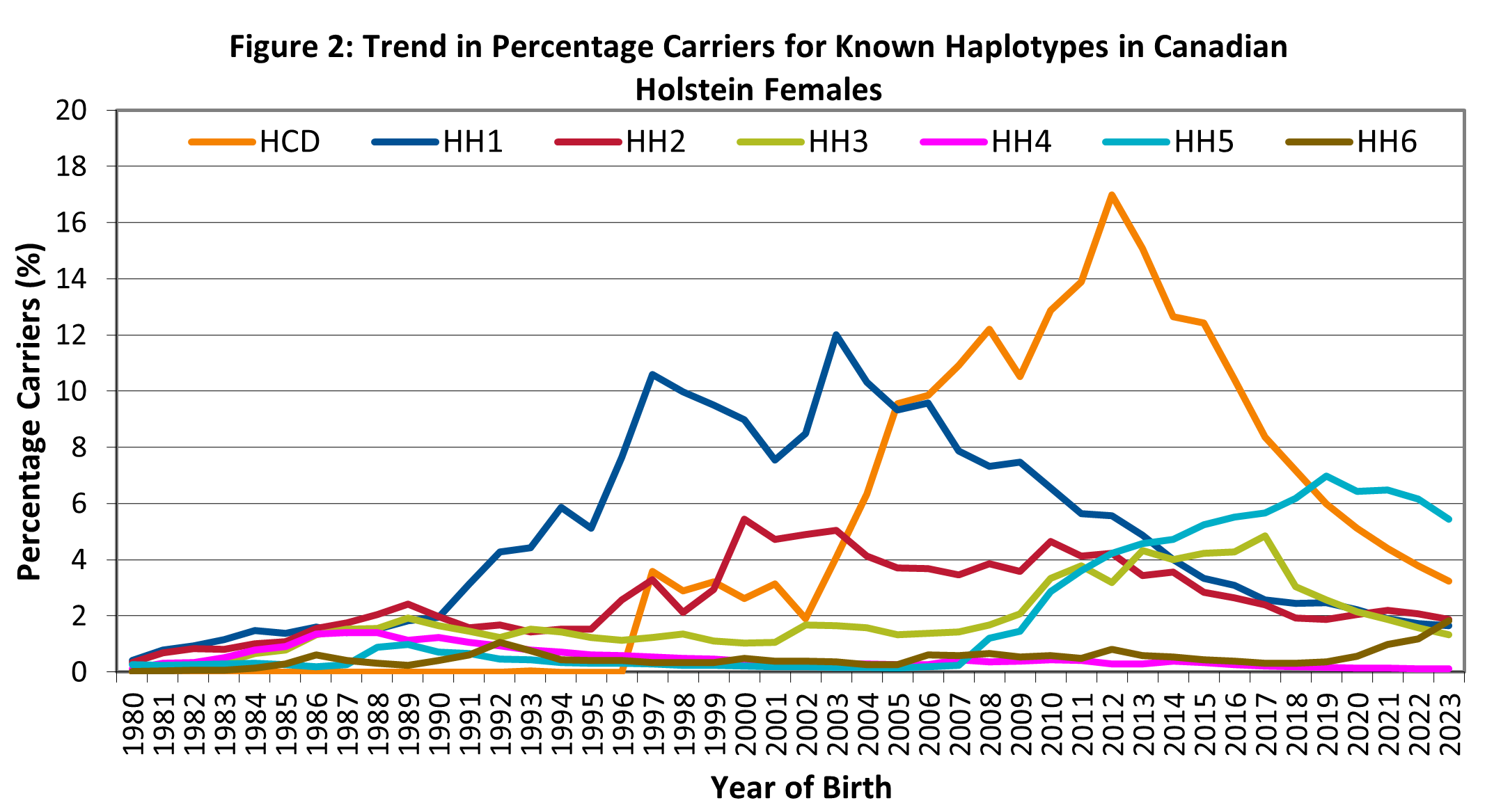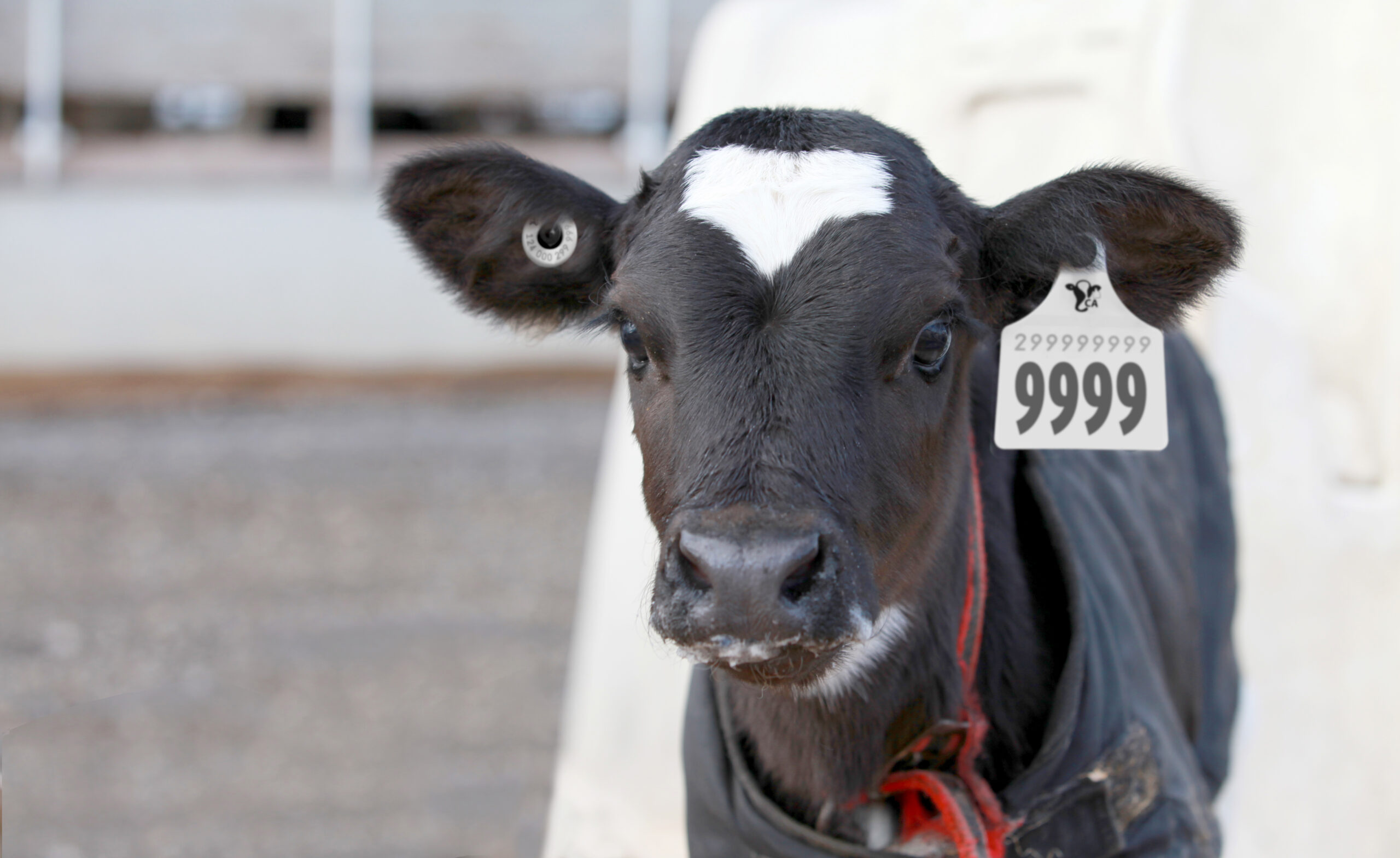Trends in Haplotypes and Genetic Recessives
- January 22, 2024
Genotyping has cemented its place as a vital tool in the dairy industry with a plethora of benefits including the identification of genetic recessives and haplotypes across several breeds. Despite the negative impact these genetic anomalies have on farm profitability, genotyping provides the opportunity to identify, monitor, and eventually eliminate them from the population. In this article, we discuss the updated trends by year of birth associated with the frequency of the genetic recessive traits and haplotypes in Canadian-born females within each breed.
Recessive Trait vs Haplotype
Recessive traits are expressed when the same copy of an undesirable gene is inherited from each parent. Recessive traits have a known gene that causes the undesirable characteristic and therefore have a specific label assigned to animals that are free or carriers of that gene. For example, the code for Brachyspina (BY) is either BYC for tested carriers or BYF for non-carriers. When the gene is not known, genotypes can be analyzed to identify short strands of DNA called haplotypes that may include one or more genes. Some haplotypes can be undesirable and lead to infertility, embryonic loss and/or stillbirth. The identification of these haplotypes allows for carrier animals to be detected so the spread of the unknown gene is controlled.
One such way of managing these genetic abnormalities is through the Lactanet website. Genetic test results for recessive traits are displayed on each animal’s Genetic Evaluation Summary page found via the Animal Query tool on the Lactanet website. In addition, a Carrier Probability is displayed on the Pedigree page to reflect the likelihood an animal carries a given haplotype. A Carrier Probability of 1% indicates the animal is very likely not a carrier whereas a Carrier Probability of 99% indicates the animal most likely carries the undesirable haplotype.
Trends in Genetic Abnormalities in the Holstein Breed
There are several recessive traits officially recognized by Holstein Canada and the World Holstein Friesian Federation (WHFF), the majority of which cause early embryonic death or affect the calf’s ability to survive. These conditions are expressed when the animal receives the undesirable gene from both parents. Figure 1 illustrates the trends in percentage of Canadian Holstein females estimated to be carriers of five genetic recessives. The discovery of these genetic abnormalities has allowed for the industry, including A.I. companies, to identify carrier animals resulting in proper control of these traits in the Holstein population. For example, Brachyspina was first discovered in 2007, shortly thereafter a gene test was developed and since 2011 there has been a rapid decline in the frequency of carriers. The percentage of Canadian Holstein females born in 2023 estimated to be carriers of Brachyspina is now around 1%.
There are also several known undesirable haplotypes affecting the Holstein breed, including six that impact fertility (HH1 to HH6) and one associated with Cholesterol Deficiency (HCD). Figure 2 shows the trend in percentage carriers for haplotypes in Canadian Holstein females. A similar trajectory to the recessive traits can be seen, whereby the discovery of the haplotypes and the introduction of genomics has initiated a downward trend in percentage carriers. One small exception is, HH6 which was discovered in 2019 and has reached an estimated frequency of nearly 2% for Canadian Holsteins born in 2023. Since our last trend update in 2019, the percentage of carriers for HH5 has started to decrease each year and is now close to 5% for animals born in 2023. Moreover, for Holstein animals born between 2020 and 2023 the frequencies of HH1 to HH4 are now below the 2% level.
The latest genetic defect affecting the Holstein breed, now named Early Onset Muscle Weakness Syndrome, was recently discovered by a group of researchers at Pennsylvania State University. This “Muscle Weakness” (MW) syndrome is characterized by muscle weakness exhibited in otherwise healthy calves, causing an inability to stand within the first six weeks of life. A haplotype-based analysis has been developed in the United States and in the coming months Lactanet will use those results to calculate and display Carrier Probability values for MW on our website. Keep an eye out for an article with more details.


Trends in Genetic Abnormalities in the Coloured Breeds
In addition to the Holstein breed, there are several known genetic abnormalities affecting the Ayrshire, Jersey, and Brown Swiss breeds (Figure 3). This includes haplotypes affecting fertility, of which there are two known in the Ayrshire breed (AH1 and AH2), as well as one each in the Jersey (JH1) and Brown Swiss (BH2) breeds. Despite a general decline in the percent of carriers in the Canadian female population for these haplotypes, they remain important for the coloured breeds to manage with 5% to 22% of heifers born each year being carriers, depending on the haplotype.
Most notably, the percent of carriers in the female Ayrshire population for AH2 has fluctuated around 20% to 25% since 2008. On the other hand, a downward trend is now observed for Curly Calf Syndrome (AM = Arthrogryposis Multiplex), which is the most recent genetic abnormality identified in the Canadian Ayrshire population. This recessive trait causes deformed and stiff joints that are curved or hooked. The percentage of AM carriers increased between 2020 and 2021 but has dropped to below 15% for Ayrshires born in 2023. Ayrshire Carrier Probabilities should continue to be closely monitored before making mating decisions to further reduce these trends.
Lastly, the most recent identified haplotype in the Jersey breed is Jersey Neuropathy with Splayed Forelimbs (JNS). This undesirable genetic trait results in a calf that is born with neurologic symptoms and an inability to stand. The estimated percentage of JNS carriers born in 2023 was 6.6%, an improvement from 8% in 2019. A new haplotype affecting fertility in the Brown Swiss breed, BH14, was also recently identified and routinely published in United States. In addition to MW in the Holstein breed, Lactanet will display Carrier Probability values for BH14 in the coming months.

Summary
The significant level of genotyping since the introduction of genomics has allowed for the discovery of genetic recessives and haplotypes within each breed. Proper management using gene tests, haplotype results and Lactanet’s carrier probabilities to avoid mating potential or known carrier animals together can be used as an effective tool to limit the spread of these genetic abnormalities. Keep an eye out in the coming months for additional management tools provided by Lactanet, including an update to the Inbreeding Calculator!












